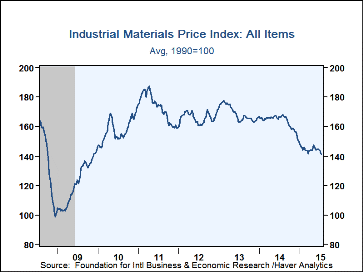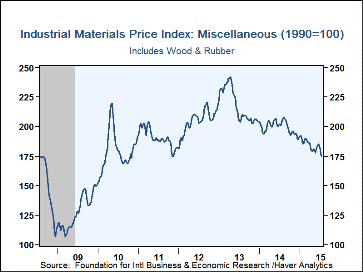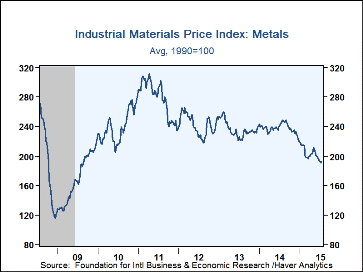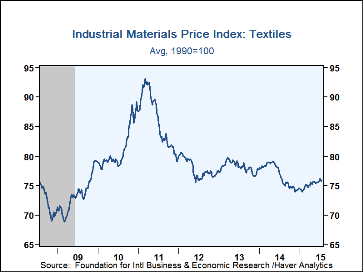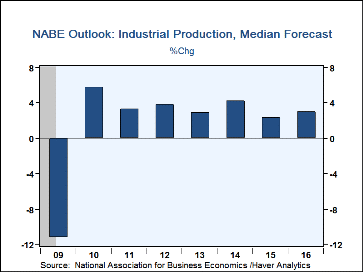 Global| Jul 20 2015
Global| Jul 20 2015FIBER: Industrial Commodity Prices Ease
by:Tom Moeller
|in:Economy in Brief
Summary
The industrial commodity price index from the Foundation for International Business and Economic Research (FIBER) deteriorated during the last month. Factory sector production so far this year, both total and industrial supplies, has [...]
The industrial commodity price index from the Foundation for International Business and Economic Research (FIBER) deteriorated during the last month. Factory sector production so far this year, both total and industrial supplies, has been unchanged, thus providing little strength in demand.
Within the sector groupings of prices, the FIBER measures show broad-based weakness. Earlier improvement in the crude oil & benzene grouping gave way to a sharp decline, as shale oil and Saudi Arabian output remained strong. The price for a barrel of WTI crude oil neared $50.00 during July. It remained up, however, versus the January low of $44.43. Alternatively, prices for the petro-chemical benzene approximated the highest level since December, but still were down roughly 40% y/y. Prices in the miscellaneous materials grouping also eased, led by declines in natural rubber (-12.7% y/y) and random lengths of structural panel composite (-5.8% y/y). Framing lumber prices, alternatively, moved to the highest level since February, though still were down 8.2% y/y. In the metals sector, prices continued to weaken. Aluminum prices declined to the lowest level since the recession, down 14% y/y. Copper scrap prices also fell to the lowest level since the end of 2009 (-21.8% y/y), despite an uptick last week. Steel scrap prices also neared the recovery low, off 31% y/y. Lead prices similarly remain depressed, off 14.7% y/y. Prices in the textile sector showed comparative strength with a 2.2% uptick (-0.9% y/y) since this winter. Cotton prices moved up roughly 6.0% since December (-10.9% y/y), while burlap prices (+9.4% y/y) continued to improve versus the 2013 low.
Support for commodity prices may be on the way. The current industrial output projection from the National Association for Business Economics calls for 2.3% production growth in 2015 followed by a 3.0% rise next year. This year's projected increase is diminished, however from earlier expectations. During the last ten years, there has been a 52% correlation between the three-month change in prices and the change in industrial output.
Commodity price data can be found in Haver's DAILY, WEEKLY, USECON and CMDTY databases.
Oil Markets Stabilizing, but OPEC Supply Raises Concerns from the Federal Reserve Bank of Dallas is available here.
| FIBER Industrial Materials Price Index (1990=100) | 07/17/15 | 1-Mth % | 3-Mth % | 6-Mth % | Y/Y % | 2014 | 2013 | 2012 |
|---|---|---|---|---|---|---|---|---|
| All Items | 141.08 | -2.3 | -2.0 | -3.3 | -15.2 | 163.5 | 169.0 | 166.3 |
| Textiles | 75.38 | 0.1 | 0.3 | 1.9 | -0.9 | 76.8 | 78.2 | 77.8 |
| Cotton (cents per pound) | 62.36 | -0.0 | 1.1 | 6.3 | -10.9 | 73.6 | 79.6 | 74.4 |
| Metals | 194.55 | -1.6 | -5.2 | -10.0 | -21.3 | 237.8 | 236.2 | 242.7 |
| Aluminum ($ per metric ton) | 1,660.10 | -0.9 | -9.0 | -6.6 | -7.9 | 1,864.9 | 1,846.7 | 2,016.6 |
| Copper Scrap (cents per pound) | 252.10 | -3.8 | -7.1 | -5.9 | -14.5 | 311.7 | 332.3 | 360.3 |
| Steel Scrap ($ per ton) | 247.27 | -0.8 | 7.5 | -20.4 | -30.2 | 358.3 | 345.8 | 366.5 |
| Crude Oil & Benzene | 154.76 | -1.8 | 0.6 | 12.0 | -30.2 | 205.2 | 207.7 | 204.0 |
| Crude Oil (WTI, $ per Barrel) | 51.82 | -13.4 | -8.3 | 10.9 | -43.8 | 93.5 | 97.9 | 94.2 |
| Miscellaneous | 185.08 | -5.2 | -2.2 | -8.1 | -12.8 | 199.6 | 218.3 | 205.2 |
| Framing Lumber ($ per 1000 board ft.) | 348 | 4.8 | 4.8 | -9.1 | -8.2 | 383 | 383 | 321 |
| Natural Rubber (cents per pound) | 122.61 | -11.0 | -0.8 | -0.4 | -12.7 | 140.2 | 190.0 | 21.8 |
Tom Moeller
AuthorMore in Author Profile »Prior to joining Haver Analytics in 2000, Mr. Moeller worked as the Economist at Chancellor Capital Management from 1985 to 1999. There, he developed comprehensive economic forecasts and interpreted economic data for equity and fixed income portfolio managers. Also at Chancellor, Mr. Moeller worked as an equity analyst and was responsible for researching and rating companies in the economically sensitive automobile and housing industries for investment in Chancellor’s equity portfolio. Prior to joining Chancellor, Mr. Moeller was an Economist at Citibank from 1979 to 1984. He also analyzed pricing behavior in the metals industry for the Council on Wage and Price Stability in Washington, D.C. In 1999, Mr. Moeller received the award for most accurate forecast from the Forecasters' Club of New York. From 1990 to 1992 he was President of the New York Association for Business Economists. Mr. Moeller earned an M.B.A. in Finance from Fordham University, where he graduated in 1987. He holds a Bachelor of Arts in Economics from George Washington University.


